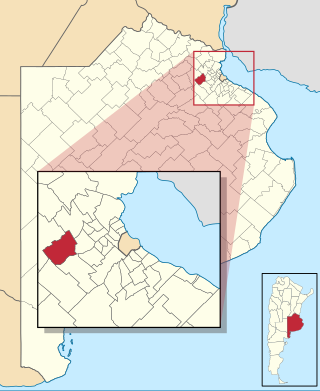
Buenos Aires, officially the Buenos Aires Province, is the largest and most populous Argentine province. It takes its name from the city of Buenos Aires, the capital of the country, which used to be part of the province and the province's capital until it was federalized in 1880. Since then, in spite of bearing the same name, the province does not include Buenos Aires city, though it does include all other parts of the Greater Buenos Aires metropolitan area. The capital of the province is the city of La Plata, founded in 1882.

La Plata is the capital city of Buenos Aires Province, Argentina. According to the 2022 census, the Partido has a population of 772,618 and its metropolitan area, the Greater La Plata, has 938,287 inhabitants. It is located 9 kilometers inland from the southern shore of the Río de la Plata estuary.

Salta is a province of Argentina, located in the northwest of the country. Neighboring provinces are from the east clockwise Formosa, Chaco, Santiago del Estero, Tucumán and Catamarca. It also surrounds Jujuy. To the north it borders Bolivia and Paraguay and to the west lies Chile.

Greater Buenos Aires, also known as the Buenos Aires Metropolitan Area, refers to the urban agglomeration comprising the Autonomous City of Buenos Aires and the adjacent 24 partidos (districts) in the Province of Buenos Aires. Thus, it does not constitute a single administrative unit. The conurbation spreads south, west and north of Buenos Aires city. To the east, the River Plate serves as a natural boundary.

Vicente López is a partido in the Buenos Aires metropolitan area, Buenos Aires Province, Argentina. It is one of the country´s most affluent municipalities.

Malvinas Argentinas Partido is a partido in Buenos Aires Province, Argentina, in the Gran Buenos Aires urban area. It has an area of 63.8 km2 (24.6 sq mi) and according to the preliminary results of the 2010 Census, the population was 321,833 inhabitants.. Its capital is Los Polvorines, and its largest city is Grand Bourg.

La Matanza is a partido located in the urban agglomeration of Greater Buenos Aires, Buenos Aires Province, Argentina.

National Route 9 is a major road in Argentina, which runs from the center-east to the northwest of the country, crossing the provinces of Buenos Aires, Santa Fe, Córdoba, Santiago del Estero, Tucumán, Salta and Jujuy. It starts on Avenida General Paz, which marks the border between the Autonomous City of Buenos Aires and the surrounding province of the same name, and ends at the Horacio Guzmán International Bridge, on the La Quiaca River, traversing 1,967 km (1,222 mi). The road is a limited access motorway from Buenos Aires to Rosario.

Morón is a partido of the Buenos Aires Province, Argentina. Located in the Greater Buenos Aires urban area, its head town is Morón which is located around 17 km (11 mi) from Buenos Aires.

Adolfo Alsina is a western partido of the Buenos Aires Province, Argentina, found at coordinates 37°10′S62°44′W.

General Rodríguez is a western partido of Buenos Aires Province, in Argentina. It is a district on the far western outskirts of Greater Buenos Aires.

Cañuelas Partido is a partido of Buenos Aires Province in Argentina. It has a population of 42,575 in an area of 1,200 km2 (460 sq mi), and its administrative centre is Cañuelas, which has a population of around 24,380.

Tres de Febrero is a partido of the Greater Buenos Aires conurbation area in the Buenos Aires Province, Argentina.

San Miguel is a city in the northwest region of Greater Buenos Aires, 30 km from the City of Buenos Aires. San Miguel is the county seat of San Miguel Partido, and has been a part of Greater Buenos Aires since the early 2000s. The number of inhabitants was 157,532 according to the 2001 census.

Esteban Echeverría Partido is a partido in the Gran Buenos Aires urban area, in Buenos Aires Province in Argentina.

San Miguel Partido is a partido in the Greater Buenos Aires urban area of Buenos Aires Province in Argentina.
Conesa is a town in San Nicolás Partido, Buenos Aires Province, Argentina. It is located next to National Route 188, 35 km from San Nicolás de los Arroyos, 43 km from Pergamino and a few kilometers from the border with Santa Fe Province, bordering the Santa Fe town of Juan Bernabé Molina.
















